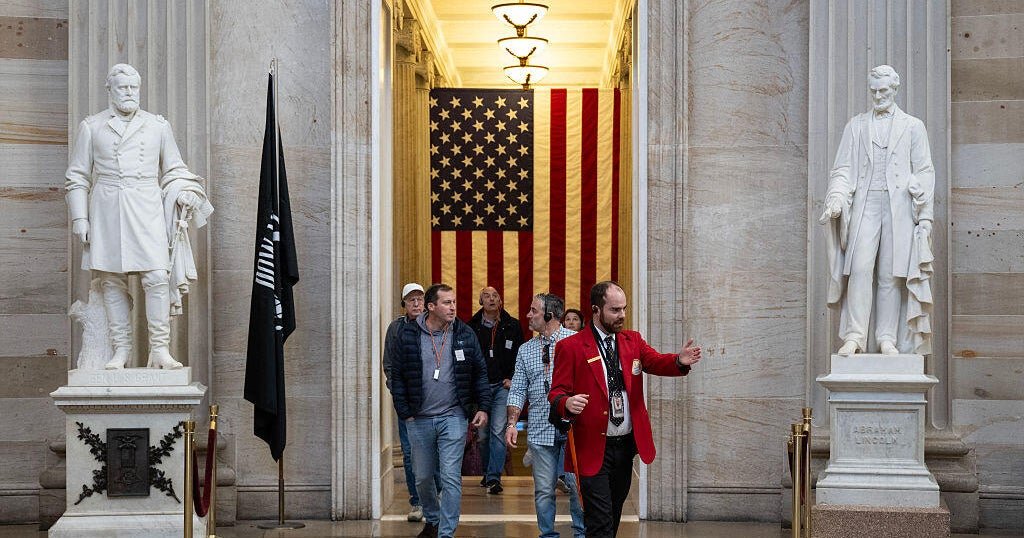2m ago
Top Trump economic adviser says roughly 60,000 non-federal workers lost jobs due to shutdown
Speaking to reporters at the White House, National Economic Council Director Kevin Hassett said the Council of Economic Advisers estimates about 60,000 non-federal workers lost their jobs due to the downstream effects of the shutdown.
He also said the administration estimates the shutdown cost the economy about $15 billion per week, or about $92 billion in total. He said gross domestic product in the fourth quarter will likely be 1.5 percentage points lower than it would have been without a shutdown.
9:55 AM
OPM says “normal operating procedures are in effect” in D.C.
A notice from the Office of Personnel Management, which manages the federal workforce, says that normal operations for federal agencies in Washington are in effect.
“Federal agencies in the Washington, DC area are open. Employees are expected to begin the workday on time. Normal operating procedures are in effect,” the notice said.
9:40 AM
When will federal employees get back pay?
The more than 1.4 million federal employees who have gone without pay during the 43-day government shutdown could begin getting paychecks as soon as this Sunday, while others will have to wait until next Wednesday, Nov. 19.
The pay schedule was laid out in an agency-by-agency projection by the White House’s Office of Management and Budget. The memo was first reported by Semafor, and an OMB official confirmed its contents to CBS News.
Hundreds of thousands of essential employees continued working during the shutdown without pay, while nonessential employees were furloughed. Both groups are entitled to back pay for the paychecks they missed while the government was closed.
The administration has a goal of completing its list of backlogged payments by Nov. 19.
Here are the projections for when employees at various agencies will start to get back pay:
- Health and Human Services, Energy Department, Veterans Affairs, Army and non-Army civilian employees: Paychecks will be processed on Sunday. This includes standard pay and overtime and hazard pay.
- Departments of Education, State, Interior and Transportation, EPA, NASA, NSF, SSA and the Nuclear Regulatory Commission: Paychecks will be sent on Monday. This will only include base pay (not including bonuses, overtime or benefits), and corrections will be made in the next pay cycle.
- GSA and OPM: Back pay processing date is Saturday, Nov. 15. This will only include base pay, and corrections will be made in the next pay cycle.
- Small Business Administration and the Departments of Agriculture, Commerce, Homeland Security, HUD, Justice, Labor and Treasury: Back pay paychecks have a projected processing date of Nov. 19. These checks cover the entire period of the shutdown, including after Nov. 1.
Read more here.
8:15 AM
Delta CEO says air travel should return to normal by the weekend
Delta CEO Ed Bastian said he expects air travel to return to normal faster than people might expect after the shutdown, saying he expects the system to return to normal by the weekend.
“By the weekend, we’re pretty much going to be full steam ahead,” Bastian told “CBS Mornings.
The Delta CEO reassured concerned fliers that “it’s incredibly safe to fly. It’s the safest form of transportation.” He said Transportation Secretary Sean Duffy “did the right,”pulling schedules down proactively when staffing levels became a concern during the shutdown. Bastian added, “we didn’t like it, yeah, but we felt like it was, it was the prudent thing to do.”
“Staff, the controllers, are back to work now. They’re going to get paid, I understand in the next day or so. And as a result, I think the system should return to normal by the weekend,” Bastian said. “I really do. And normal for us is an incredibly safe, incredibly reliable, great experience.”
As for Thanksgiving travel, Bastian said he has “no concerns.”
Updated 7:47 AM
The 2025 U.S. government shutdown, by the numbers
The longest government shutdown in modern U.S. history came to a close Wednesday night when President Trump signed a bill to fund the government through Jan. 30, ending a 43-day-long impasse.
The shutdown impacted 42 million federal food aid recipients, 670,000 furloughed federal employees and 4,000 government workers who faced layoffs. It also threatened more than $7 billion in economic damage.
Read more here.
Updated 7:47 AM
How the longest government shutdown in history came to an end
The longest government shutdown in history came to an end on Wednesday, after a Senate breakthrough ended weeks of gridlock that caused air travel disruptions, denied access to food benefits to millions and forced thousands of federal workers to go without paychecks.
The standoff stretches back to late September. House Republicans passed a short-term measure to keep the government open, facing an Oct. 1 deadline. But Democratic support was necessary to move the bill through the Senate. And with few opportunities to exert influence, Democrats set out to center health care issues in the funding fight — setting their sights on extending a set of expiring health insurance tax credits in exchange for their votes.
For most of the ensuing 43-day-long shutdown, Republicans and Democrats traded blame for the funding impasse, and each side remained largely united. But throughout it all, member-level bipartisan conversations seeking an off-ramp were bubbling under the surface.
Last weekend, the deal to end the shutdown finally came together.
Read more here.
Updated 7:47 AM
Smithsonian staggers museum, zoo reopenings
The Smithsonian Institution announced that it would stagger reopenings after the shutdown ended, with the National Museum of American History, the National Air and Space Museum, and the Steven F. Udvar-Hazy Center set to reopen on Friday. The other museums, research centers, and the National Zoo are set to reopen on a rolling basis by Monday.
Smithsonian museums, research centers and the National Zoo closed on Oct. 12 because of the shutdown, using prior-year funding to keep the entities open for more than a week after funding lapsed.

